Top 10 reasons for wearing fur
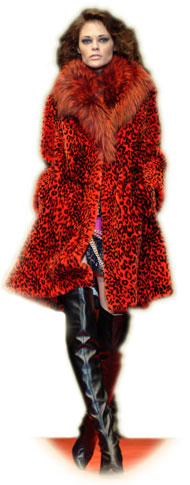 Warmth
Warmth
Warmth is the number one reason people like to wear fur, according to a recent poll of fur buyers. Fur is nature's most beautiful answer to Winter.
Fashion
Modern, casual or elegant, fur is always in style. More than 150 top international designers are now using fur in their collections.
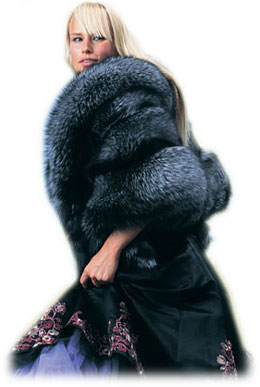 Long-Lasting
Long-Lasting
Fur is a naturally durable fiber that lasts for many, many years.
Re-Style able
As styles change, your fur can be updated and re-styled to reflect the latest fashions time and time again.
Environmentally Friendly
A fine natural product, fur is bio-degradable and a renewable resource.
Versatile
Fur can be worn for all occasions. Whether with jeans or an evening gown, wearing fur will make you look and feel terrific! With lighter weight fur and fur accessories, furs are now a three-season fashion.
Supporting Livelihoods and Cultures
When you buy fur, you support thousands of people living on the land - people who have a direct interest in protecting vital wildlife habitat. The fur trade is a proud North American heritage. http://www.furisgreen.com/furisgreen.aspx
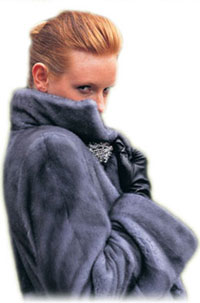 Responsible Conservation
Responsible Conservation
Furs used in the trade are abundant. Strict government controls ensure that NO endangered species are ever used.
Learn more...
Comfort
Soft, sensual, cozy and lightweight - nothing equals the feeling of wearing fur.
Fur is your choice!
The fur trade is a responsible, well-regulated industry. You can feel proud of your choice to wear natural North American furs.
What to look for
With today's wide variety of fur fashions, the choices are endless. So give some thought to your purchase:
- How will you wear your fur?
- Will you spend time in blue jeans and a funky knitted fur or a leather jacket lined in sheared beaver?
- Will you dress for an elegant night on the town in a classic mink coat?
- Or will a touch of fur add sophistication to your work wardrobe with, for example, an understated fur collar on a classic wool suit?
Once you decide which fur best fits your lifestyle, it's time to start looking.
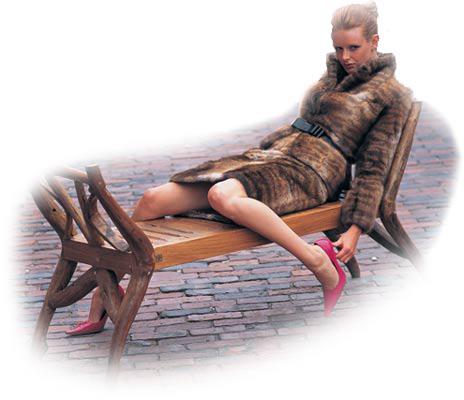
Where to look
A great place to start is at our fur salon. Feel free to browse and ask questions.
At Alex Furs they are experts who can introduce you to the world of fur.

Tips about choosing a fur:
- Check to see that the pelts are lustrous, supple and well-matched.
- Feel the fur carefully. There should be a dense, soft underfur that is evident to the touch under the glossy guard hairs, which should also be soft, never bristly.
- Seams should be sewn tightly. Hems should fall straight.
- Be sure to try the garment on to see if the weight is comfortable for you. You may be surprised at how lightweight many fur coats actually are.
- When you try on a well-made fur, it should be well-balanced, falling evenly and comfortably from your shoulders.
- There should be "give" to the leather side of the fur when horizontal tension is applied
Also see FUR CARE
Types of Fur
Types of Fur - Different fur, Different features
 |
Beaver ShearedSoft, velvety texture. Often dyed in new fashion colours. Natural: Long, lustrous guard hairs over thick underfur. |
 |
ChinchillaA short, dense soft fur with lustrous slate blue guard hairs and dark underfur. |
 |
CoyoteA long-haired fur, often pale grey or tan in colour, with thick soft underfur. Very durable fur. |
 |
ErmineVery silky white guard hairs and dense underfur. |
 |
FisherSilky guard hairs in brown to blackish tones and thick underfur. Very durable fur. |
 |
FitchLong guard hairs over light-coloured underfur. Colour ranges from pale ecru to orange tones, with black markings |
 |
FoxThe widest range of natural colours of any fur except mink. Long, lustrous guard hairs with thick, soft underfur. Fox varieties include silver cross, crystal blue, red, grey and white. Can also be dyed in a wide variety of colours. |
Lamb |
|
 |
Broadtail: A natural flat moire pattern. Natural colours include brown, black and grey. Often dyed in more exotic colours. |
 |
Mongolian: Very long, wavy, silky guard hairs. Its natural colour is off-white, but often dyed. |
 |
Mouton: Pelts are sheared closely for a soft, thick, flat fur. |
 |
Persian Lamb: From karakul sheep raised in Central Asia of Southwest Africa, fur features flat silky curls. Natural colours are black, brown and grey. |
 |
Shearling: Natural lamb pelts with the leather side sueded or leatherized and worn on the outside with the fur on the inside. |
 |
LynxCanadian Lynx: Displays creamy white tones with characteristic darker markings. |
Marten AmericanLong silky guard hairs and dense underfur. Colour ranges from blue-brown to dark brown. Baum: Softer, silkier and shinier than American marten. Stone: The finest marten has soft, thick guard hairs and a bluish-brown cast with pale underfur. |
|
 |
MinkSoft and lightweight with lustrous guard hairs and dense, soft underfur. Primarily farm-raised, mink remains the most popular fur. Female pelts are smaller in size and have a softer, silkier feel than male pelts. Minks can be died a wide range of colours and may be sheared for a sporty, casual look. Very durable fur. |
 |
MuskratFur is full and thick with a black stripe and pale beige sides. Often sheared for a sporty, lightweight feel. New Jersey: Lighter in weight with contrasting colours. Northen: Strong, longer guard hairs and heavy, thick underfur. Often worked skin-on-skin. Southern: Flatter with little underfur, usually pale in colour. |
 |
NutriaSimilar to beaver, it is often sheared for a sporty, more lightweight feel. Underfur is very soft and plush. A popular fur for linings and trims, it is frequently dyed in a variety of colours. |
 |
Opossum AmericanLong, silvery black-tipped guard hairs with thick underfur. Australian: Short, dense, plush-like fur, with colour ranging from yellow-grey to natural brown. |
 |
RabbitGenerally medium length guard hairs in a variety of colours. Often sheared or grooved. Not very durable, and may have a tendency to shed. |
 |
RaccoonLong grey/black guard hairs with silvery tips over a woolly, dense underfur. Very durable fur. Finn raccoon: Long, thick tan guard hairs with black tips and dense underfur. |
 |
SableLong, luxurious guard hairs with dense underfur, yet very lightweight. Russian sable: Brown with silver cast, it is the most expensive fur, especially when there is an abundance of silver hairs. Canadian golden sable: In amber tones, somewhat less expensive. Very durable. |
 |
SquirrelShort, soft guard hairs with a flatter, dense underfur. Very lightweight. |
 |
TanukiAlso called Japanese raccoon with very long guard hairs and a full texture. Colour is light amber brown with dark, distinctive markings. |
 |
WeaselSimilar look to mink, with short guard hairs and semi-dense underfur. |
Fur Terminology
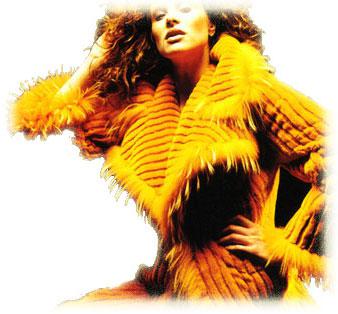 Every fur represents weeks of specialized labour and fine hand craftsmanship. Furriers have specialized skills which often have been handed down from generation to generation. The creation of each fur requires meticulous workmanship. The following terms describe some of the elements involved:
Every fur represents weeks of specialized labour and fine hand craftsmanship. Furriers have specialized skills which often have been handed down from generation to generation. The creation of each fur requires meticulous workmanship. The following terms describe some of the elements involved:
Brightener added
A process which enhances the colour of a fur.
Dyeing
Process of applying dye to create a new colour. Dyeing is sometimes also used to correct any imperfections and to improve uniformity. Sometimes the pelt is leached white before colour is added. Guard Hair Long, lustrous outer hair that protects the underfur.
Knitted Fur
A new technique that produces a soft, comfortable, fur-in/fur-out look and feel.
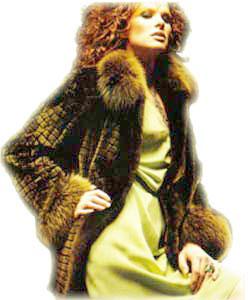 Leathering
Leathering
Insertion of ribbon, cloth or leather strips along with fur strips. May be done for fashion or to lighten the weight of the fur.
Letting Out
Cutting the pelt into diagonal strips and resewing it to make the pelt longer and narrower. Sometimes referred to as dropping out. The effect is supple and smooth flowing.
Mutation
Natural furs of special colours that are produced by selective breeding.
Plucking
To emphasize the velvet underhair of the fur. All guard hairs are plucked before shearing.
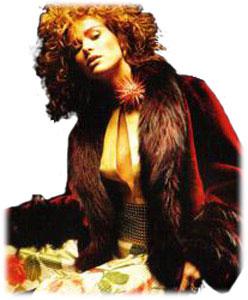
Shearing
Cutting the fur to a short, uniform pile.
Shearling
Natural lamb pelts with the leather side often sueded and worn on the outside.
Skin-on-Skin
Rectangular pelts are sewn together to create a box effect as an alternative to the letting out process.
Tip-Dyeing
Sometimes called blending. Dye is applied only to the tips of guard hairs to produce more colour uniformity.
Underfur
The underhair covered by guard hairs. This is the layer of the fur that acts as insulation to provide warmth.
Easy Care Tips
Svelte Pelts: 10 Easy care tips to keep your fur in peak condition
- Always hang your fur on a broad-shouldered hanger, never on a wire hanger. Give your fur enough room in the closet so the fur in not crushed.
- Never hang your fur in a plastic bag or rubber-lined bag. Plastic prevents air from circulating and can dry out the leather. When traveling, store your fur in a cloth garment bag provided by your furrier.
- If your fur gets wet, shake it out and hang it to dry in a well-ventilated room. Keep it away from direct heat or a radiator, which can cause both fur and leather to dry out. After it is dry, shake it again. Most furs will take some rain and snow far better than wool or other winter coat will. If the fur is soaked through, however, take it immediately to your fur retailer for proper treatment. Never comb or brush the fur.
- Never pin jewellery on your fur. Do not use shoulder straps of a handbag on a consistent basis.
- Never attempt to mothproof your fur yourself. Home treatments are no substitute for professional cleaning and storage.
- Avoid spraying perfume or hairspray onto your fur.
- Always store your fur during warm weather with your furrier - never at a dry cleaner. Your furrier is equipped with temperature, humidity and light-controlled storage facilities to protect fur.
- Have fur cleaned annually by a fur specialist, definitely not by a dry cleaner.
- Have small rips or tears repaired immediately by your furrier. This will prevent more expensive repairs later.
- Avoid leaving a fur hanging in a bright place. The light can cause the fur to oxidize or change colour.
Questions to ask
The 10 Most Frequently Asked Questions When Buying A Fur:
- What is the difference between female and male mink coats?
- Where should I go to buy a fur coat?
- How much should I spend for a good quality fur?
- Is a sheared fur as warm as an unsheared fur?
- Does dyeing a fur affect its quality?
- Will rain ruin a fur?
- What is shearling?
- Are long-hair furs warmer than short-hair furs?
- What can I do with an old fur that I inherited from my mother?
- How do I respond to those that question my choice to wear fur?
1. What is the difference between female and male mink coats?
Female mink is generally lighter in weight, softer and more supple than male mink. Additionally, female pelts have higher luster, are very silky and soft and are more adaptable to tailoring and draping. Male mink is often used to create a different fashion look and is also of excellent quality.
2. Where should I go to buy a fur coat?
Always buy a fur from a reputable fur salon or fur retailer. In this way, you are assured of customer service, plus a variety of styles and price ranges from which to choose.
3. How much should I spend for a good quality fur?
Always buy the best quality fur in your price range. Some factors that determine cost are fur quality, type of fur, craftsmanship, style and the designer label. Other factors include the length, size and sweep of the garment.
4. Is a sheared fur as warm as an unsheared fur?
Yes. The warmth of the fur is determined by the underfur, which acts as insulation. Whether or not the guard hairs have been sheared, the underfur remains.
5. Does dyeing a fur affect its quality?
Yes, but in a very minimal way. The fur may not be quite as soft as it was in its natural form.
6. Will rain ruin a fur?
A mild rain will not harm your fur. Just hang the garment to dry in a well-ventilated room, away from direct heat. After it is dry, give the fur a vigorous shake. If your fur gets thoroughly soaked, bring it to the place of purchase immediately for proper treatment so that oils can be applied to the leather side of the fur to maintain its suppleness. In some cases, the silk lining may need to be replaced.
7. What is shearling?
Shearling is natural lamb with the leather side often sueded and dyed colours. The sueded side is worn on the outside with the fur on the inside.
8. Are long-hair furs warmer than short-hair furs?
No. As with sheared furs, warmth is determined by the dense underfur. The outer guard hairs give the various furs their individual characteristics.
9. What can I do with an old fur that I inherited from my mother?
If a fur has been cared for properly over the years (annual storage and cleaning) there are many options available. The style can be updated into a more modern silhouette. It can also be used as a liner by having an outer shell made in a fabric such as micro-fiber, cashmere or leather. You might consider using the fur as a trim on a wool coat, suit or sweater. Fur pillows will always add a luxurious accessory to a home.
10. How do I respond to those that question my choice to wear fur?
You can feel proud to wear fur because it is a natural product that comes from and is produced by a responsible, well-regulated industry. People have every right to appreciate the qualities of fine, natural products such as leather, wool, silk, down, shearling and fur.
Canada's Premier Custom Furrier
Telephone: 1.416.703.0734 Email: info@alexfurs.com
Navigation
Shop Alex Furs
- Shop Collection
- Gift Cards
Customer Care
- Exchange Policy
- Domestic Shipping
- International Shipping
- Order Status & Tracking
- Women's Size Chart
- Men's Size Chart
- Payment Information
- Sales Tax Information
- Order Status & Tracking
- Contact Alex Furs
Copyright 1986 - 2024 Alex Dimitropoulos Furs Limited All Rights Reserved. | Terms and Conditions | Security & Privacy Statement
















